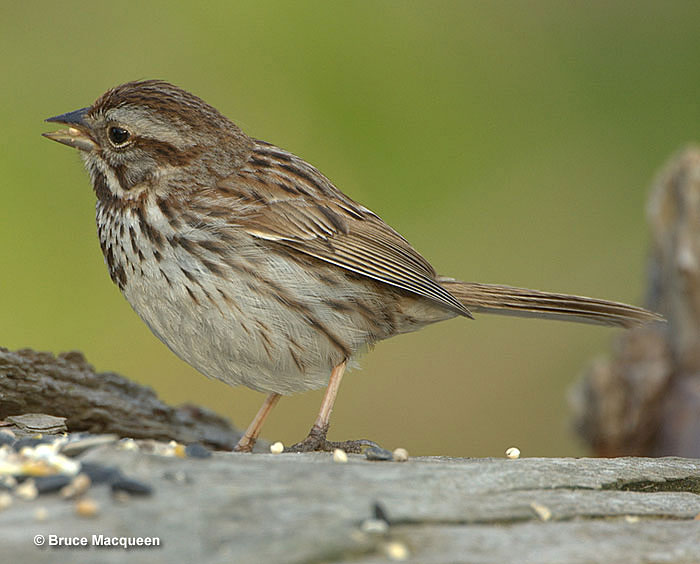The Song Sparrow (Melospiza melodia) is a small gray and brown songbird with streaked underparts and a dark spot on its chest.
A sparrow singing from a bush or woodpile in a park or even in your own backyard might be this species. If the bird is plain gray and brown but has streaked underparts, there’s a pretty good chance it’s a Song Sparrow.
In many parts of North America, this small bird is one of the more common and familiar sparrows.
On this page
Identification
The Song Sparrow is a small gray and brown, mottled songbird. On average, they are 6.25 inches long, have a wingspan of 8.25 inches, and weigh .7 ounces. Both sexes look the same but males are slightly bigger than females. However, the size difference is too small to notice in the field.
This bird has a rather small conical, finch-like beak, has rounded wings, and a fairly long, rounded tail.
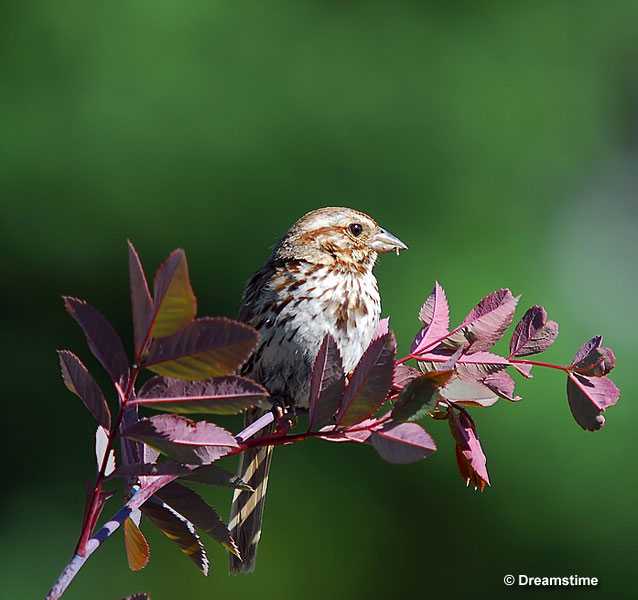
Song Sparrows are gray and red-brown above with streaks on their backs. They have mottled brown or red-brown wings, sometimes with two faint pale wing bars, and have a hint of a pale eyering.
Depending on where they occur, Song Sparrows can be darker, paler, or have different shades of brown but most birds have pale underparts with dark streaks on their sides and chest.
Most also have a dark spot on their chest, and a pale throat with dark borders.
They have a gray line on their crown, gray eyebrow, dark line going back from their eyes, and a dark mark on their face.
In the Aleutian Islands, Song Sparrows are larger and darker gray overall.
Song Sparrows sing a cheerful warbling song, “swit swit, swert swit treeeeeeee”.
Food
Song Sparrows eat a variety of seeds, berries, and insects. During the breeding season, like many birds, most of their diet is made up of insects and other arthropods. They take advantage of more bugs being available in spring and summer but still eat some berries.
In fall and winter, as insect numbers decline, they switch most of their diet to seeds and berries.
The Song Sparrow catches just about any insect or spider they can find with ants, beetles, and larvae being common food items. They can also eat snails and feed on many grass seeds, some grain, ragweed, and various other plants.
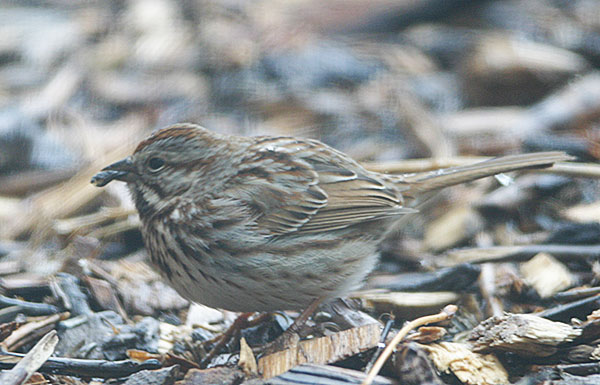
Some of the berries Song Sparrows feed on include blackberries, mulberries, and blueberries. In general, though, they don’t feed on apples or other fruit crops.
Song Sparrows forage on and near the ground, often next to or even in shallow water. They find seeds by scratching the ground with both feet and picking up seeds from the ground. These sparrows can also take some seeds directly from vegetation and catch arthropods in similar ways.
These adaptable birds pick bugs from low brush, logs, the edge of water, foliage, and other places. They can also catch bugs in the air and eat berries while perched in low bushes.
Nesting and Eggs
The female Song Sparrow starts to build her nest two to four weeks before laying her eggs. She uses bark strips, grass, twigs, rootlets, and other bits of vegetation to make an open, cup nest.
She builds it on or near the ground in any number of spots where the nest can be hidden and protected from wind and rain. Common sites are under a grass tuft, in a flowerbed, on a low branch over water, or even in a hollow log or other crevice.
She lays three to five grayish-green eggs heavily speckled with brown or red-brown spots. On average, the eggs are .38 inches long and weigh .08 ounces each.
Female Song Sparrows incubate their eggs for 12 to 14 days without any help from the male. However, once the eggs hatch, both parents feed the young birds insects and other arthropods. The baby birds leave the nest after ten days with each young bird going to a separate spot in nearby vegetation.
They can feed themselves 13 days after hatching but are fed by their parents for 30 days after leaving the nest. At three months of age, young Song Sparrows flock together. Males start to sing and establish territories when they are four months old.
Current Situation
The Song Sparrow has a big range that includes coastal Alaska, Canada north to the edge of subarctic regions, and most of the lower 48 states. It also lives in parts of northern and central Mexico. It is a wintering species in much of the deep south, parts of the Great Plains, Texas, and New Mexico.
This species uses brushy habitats, second growth, and various other edge habitats.
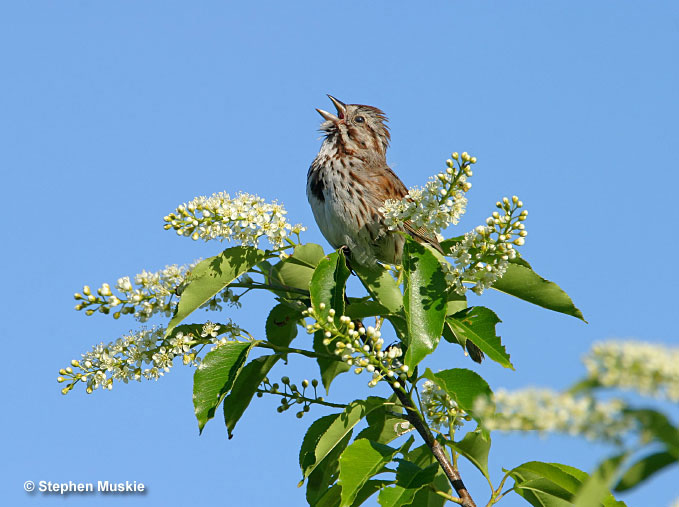
They are listed as Least Concern in the IUCN Red List, and are a very common bird throughout their range.
Some distinct Song Sparrow subspecies that live on islands and in tidal habitats of California have declined and are birds of special concern. The subspecies restricted to central Mexico may also be threatened with habitat loss.
Song Sparrows that live near people are also very vulnerable to being killed by outdoor cats. In general, though, this species is common and has a large and stable population.
Facts
- The Song Sparrow often lays more than one clutch per breeding season. They have even been documented raising four successful clutches in one season! This sparrow lays more than one clutch to take advantage of abundant food sources or to replace earlier clutches lost to predators or bad weather.
- Song Sparrows can look quite different in different parts of their range. Desert birds are pale, birds that live on the Pacific coast are dark and heavily streaked, and the ones that live in coastal Alaska barely look like the same species. These Aleutian Song Sparrows are much larger and darker gray!
- This species is one of the most common bird species in North America. Some studies have given the Song Sparrow an estimated population of 130 million birds!
- Sparrows symbolize many things, including friendship and harmony.
- Like most birds, Song Sparrows love to bathe. They can bathe in puddles, in salt water, and can also bathe by flying against wet leaves and other foliage. This species can also visit backyard water features like bird baths and fountains.
Similar Species
The Song Sparrow doesn’t have as many obvious field marks as some other birds. It takes a close look to separate it from some similar sparrows including the following species.
Lincoln’s Sparrow
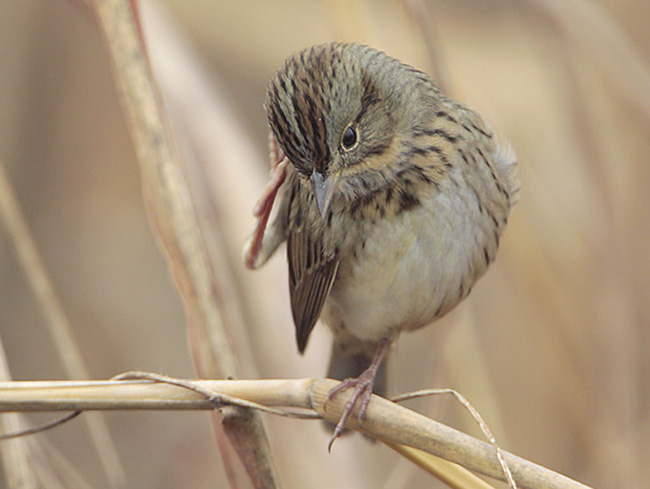
This species is very similar to the Song Sparrow and the two birds are frequently confused with each other.
The Lincoln’s Sparrow is a smaller and more delicate bird with a daintier beak. Most of all, it has fine dark streaking on its buff chest and flanks. This little bird also seems to have a more pronounced, buffy eyering.
Savannah Sparrow
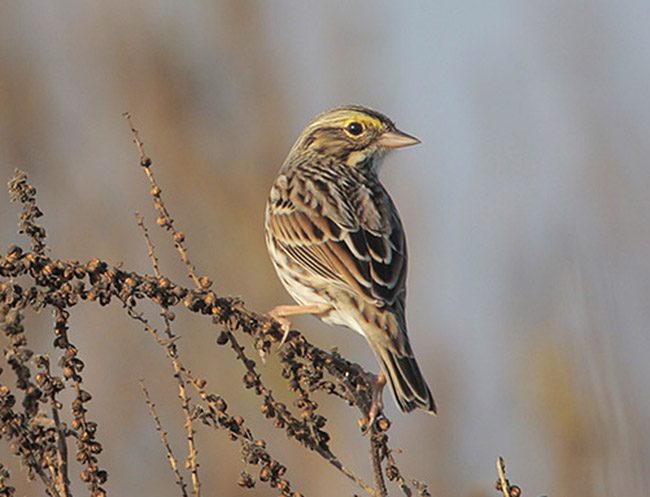
Like the Song Sparrow, the Savannah Sparrow is another sparrow with streaked underparts. However, it is usually a paler, grayer bird with a slightly forked tail. The Savannah Sparrow also often has a pale yellow spot in front of its eyes and lives in more open and barren habitats.
Fox Sparrow
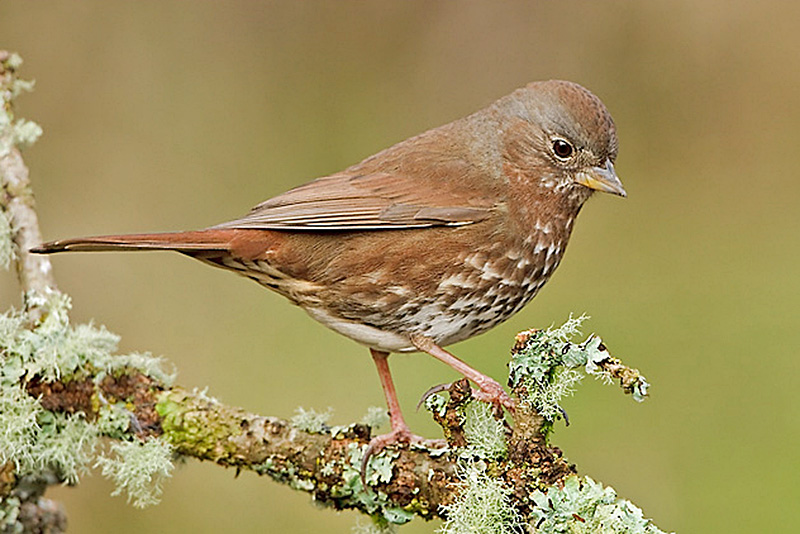
This sparrow has some similar features but is a bigger and chunkier bird with a larger or paler beak. It also has a more uniformly colored head, and western birds have unstreaked backs.
In the east, Fox Sparrows have more red-brown plumage than Song Sparrows, especially on their head and underparts.
Frequently Asked Questions
Why is it called a Song Sparrow?
It is called a Song Sparrow because it often sings a cheerful, trilling song in big gardens and parks.
What is special about Song Sparrow?
The Song Sparrow is special because it is one of the most common sparrow species, lives near people, and occurs as several distinctive subspecies.
How do I identify a Song Sparrow?
You identify a Song Sparrow by its white underparts with dark streaks on its chest and sides, a dark spot on its chest, rounded tail, and dark borders on its pale throat.
What’s the difference between a House Sparrow and a Song Sparrow?
The difference between a House Sparrow and a Song Sparrow is that the House Sparrow lacks streaking, has a heftier beak, has different plumage, and is more common in urban areas.
What is the difference between a Song Sparrow and a White-throated Sparrow?
The difference between a Song Sparrow and a White-throated Sparrow is that the White-throated Sparrow doesn’t have any dark streaking on its underparts, is grayer below, and has a bolder pattern on its head.

